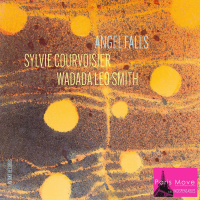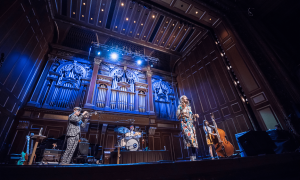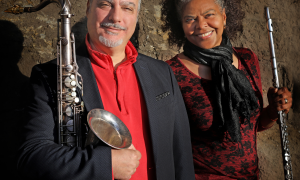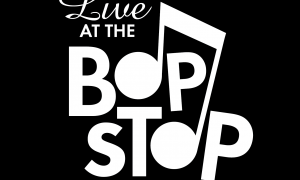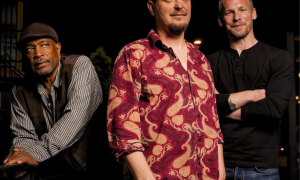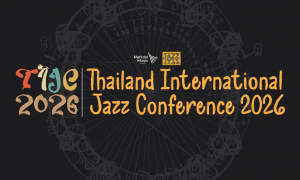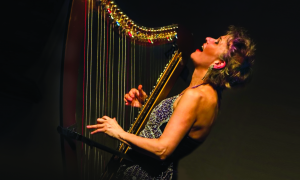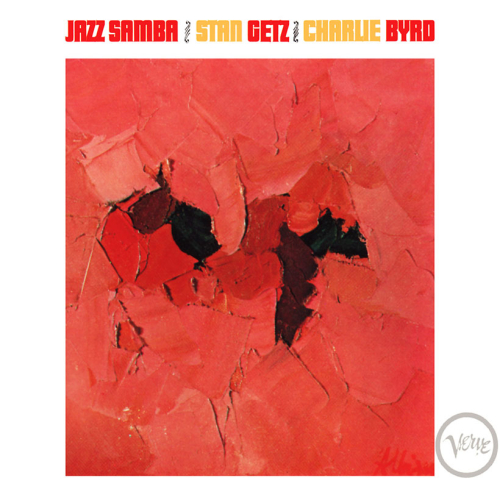
One of America's first champions of Brazilian bossa nova was Felix Grant. A jazz disc jockey in Washington D.C., Grant hosted The Album Sound on WMAL. His voice had a soft, sophisticated on-air sound that caught the ear of listeners. Among those tuning into his show in 1960 was Dr. João Oliveira Santos, an economist and head of the International Coffee Agreement, a Brazilian trade group. A fan of Grant's show, he introduced Grant to his brother, Paulo Santos, a disc jockey in Rio de Janeiro.
Paulo Santos was in Washington visiting his brother after the 1960 Newport Jazz Festival was upended. Unruly crowds had descended on the Rhode Island port town only to find that the outdoor concert venue was sold out. The National Guard was called in to restore order. Enthralled by Paulo, Grant invited him to come on his WMAL show and to bring along some Brazilian albums. Grant turned over his show to Santos, urging him to play music that was representative of what he played in Brazil. Santos played a couple of albums by João Gilberto. After Paulo Santos returned to Rio, he and Grant stayed in touch and swapped albums through trade groups traveling back and forth. In Washington, Grant began to play bossa nova records routinely on his show.
In early 1961, relations between Brazil and the U.S. began to grow problematic. Two years had passed since Fidel Castro's Cuban Revolution, and the State Department was worried that Communism might take hold among people in economically strained Latin and South American countries. To make matters more complicated, Brazil's newly elected president, Jânio Quadros, was trying to balance trade relations between the U.S. and Eastern Europe.
In January 1961, when Quadros assumed power, Brazil faced skyrocketing inflation and ballooning foreign debt. To remain independent, Quadros was keeping his distance from the U.S., a move that set the State Department and CIA on edge. In an effort to bypass the governments and win over the populations of these countries to American-style democracy, the State Department arranged a 12-week tour of South America countries by jazz musicians as part of a cultural exchange program.
Musicians were invited along with business executives hoping to cultivate trade ties. Guitarist Charlie Byrd replaced Dave Brubeck, whose recording and tour schedules prevented him from going. Bassist Keter Betts and percussionist Buddy Deppenschmidt accompanied Byrd. Also along on the performance tour were Kenny Dorham, Curtis Fuller, Zoot Sims, Al Cohn, Herbie Mann, Ahmed Abdul-Malik, Ronnie Ball, Ben Tucker, Dave Bailey, Ray Mantilla and others.
When the tour ended, Byrd, Betts and Deppenschmidt returned to the states loaded with Brazilian bossa nova albums and plans to record a jazz-samba LP. Creed Taylor, the head of Verve, suggested that Byrd add Stan Getz. The result was the recording of Jazz Samba in February 1962, an album that featured Desafinado, which became a huge hit. Later that year, the State Department dispatched another group of musicians and executives on a six-month tour of 23 countries in South America. Paul Winter and Herbie Mann were among them, and each recorded bossa nova albums in Rio that year.
Here's how the bosssa nova exploded in the U.S. in 1962, launching a Brazilian Invasion:
Here is Desafinado from João Gilberto's 1959 album, Chega de Saudade. Recorded in Brazil for Odeon, it is considered one of the first pure bossa-nova albumsn...
Here's the Dave Brubeck Quartet in January 1962 recording Vento Fresco from Bossa Nova USA...
Here's Stan Getz and Charlie Byrd recording Desafinado from Jazz Samba in February 1962...
Here's Herbie Mann recording One Note Samba from his Brazil, Bossa Nova & Blues, recorded in late 1961 or early '62...
Here's Herbie Mann recording Voce E Eu from Do the Bossa Nova With Herbie Mann in October 1962...
Here's Paul Winter recording Journey to Recife in 1962 from Jazz Meets The Bossa Nova...
Here's Shorty Rogers recording Chega de Saudade in 1962 from Shorty Rogers and His Giants: Bossa Nova...
Here's Bud Shank in September 1962 recording Joao from Bossa Nova, Jazz Samba...
By the fall, the bossa nova was a full-blown jazz rage, and recording studios were filled with artists recording jazz samba albums. These included Bossa Nova Carnival: Dave Pike Plays the Music of Joao Donato, Gene Ammons's Bad! Bossa Nova, Ramsey Lewisis's Bossa Nova, Charlie Byrd's Bossa Nova Pelos Passaros, Laurindo Almeida's Viva Bossa Nova and Ole! Bossa Nova, Ike Quebec's Bossa Nova Soul Samba, Lalo Schifrin's Piano, Strings & Bossa Nova, Zoot Sims's New Beat Bossa Nova Vols. 1 and 2, Eddie Harris's Bossa Nova, Charlie Rouse's Bossa Nova Bacchanal, Cannonball Adderley's Cannonball's Bossa Nova and George Shearing's Bossa Nova.
On November 21, 1962, the first bossa nova concert was held at Carnegie Hall. It featured all of the major stars of the music, who came up from Brazil. Many would remain as part of the cultural-exchange program and record for American labels.
JazzWax clip: Here's Felix Grant's 1963 radio interview of Joao Gilberto that I stumbled across yesterday and set this post in motion...
For more on the bossa nova, visit the Bossa Nova Project (go here).
Paulo Santos was in Washington visiting his brother after the 1960 Newport Jazz Festival was upended. Unruly crowds had descended on the Rhode Island port town only to find that the outdoor concert venue was sold out. The National Guard was called in to restore order. Enthralled by Paulo, Grant invited him to come on his WMAL show and to bring along some Brazilian albums. Grant turned over his show to Santos, urging him to play music that was representative of what he played in Brazil. Santos played a couple of albums by João Gilberto. After Paulo Santos returned to Rio, he and Grant stayed in touch and swapped albums through trade groups traveling back and forth. In Washington, Grant began to play bossa nova records routinely on his show.
In early 1961, relations between Brazil and the U.S. began to grow problematic. Two years had passed since Fidel Castro's Cuban Revolution, and the State Department was worried that Communism might take hold among people in economically strained Latin and South American countries. To make matters more complicated, Brazil's newly elected president, Jânio Quadros, was trying to balance trade relations between the U.S. and Eastern Europe.
In January 1961, when Quadros assumed power, Brazil faced skyrocketing inflation and ballooning foreign debt. To remain independent, Quadros was keeping his distance from the U.S., a move that set the State Department and CIA on edge. In an effort to bypass the governments and win over the populations of these countries to American-style democracy, the State Department arranged a 12-week tour of South America countries by jazz musicians as part of a cultural exchange program.
Musicians were invited along with business executives hoping to cultivate trade ties. Guitarist Charlie Byrd replaced Dave Brubeck, whose recording and tour schedules prevented him from going. Bassist Keter Betts and percussionist Buddy Deppenschmidt accompanied Byrd. Also along on the performance tour were Kenny Dorham, Curtis Fuller, Zoot Sims, Al Cohn, Herbie Mann, Ahmed Abdul-Malik, Ronnie Ball, Ben Tucker, Dave Bailey, Ray Mantilla and others.
When the tour ended, Byrd, Betts and Deppenschmidt returned to the states loaded with Brazilian bossa nova albums and plans to record a jazz-samba LP. Creed Taylor, the head of Verve, suggested that Byrd add Stan Getz. The result was the recording of Jazz Samba in February 1962, an album that featured Desafinado, which became a huge hit. Later that year, the State Department dispatched another group of musicians and executives on a six-month tour of 23 countries in South America. Paul Winter and Herbie Mann were among them, and each recorded bossa nova albums in Rio that year.
Here's how the bosssa nova exploded in the U.S. in 1962, launching a Brazilian Invasion:
Here is Desafinado from João Gilberto's 1959 album, Chega de Saudade. Recorded in Brazil for Odeon, it is considered one of the first pure bossa-nova albumsn...
Here's the Dave Brubeck Quartet in January 1962 recording Vento Fresco from Bossa Nova USA...
Here's Stan Getz and Charlie Byrd recording Desafinado from Jazz Samba in February 1962...
Here's Herbie Mann recording One Note Samba from his Brazil, Bossa Nova & Blues, recorded in late 1961 or early '62...
Here's Herbie Mann recording Voce E Eu from Do the Bossa Nova With Herbie Mann in October 1962...
Here's Paul Winter recording Journey to Recife in 1962 from Jazz Meets The Bossa Nova...
Here's Shorty Rogers recording Chega de Saudade in 1962 from Shorty Rogers and His Giants: Bossa Nova...
Here's Bud Shank in September 1962 recording Joao from Bossa Nova, Jazz Samba...
By the fall, the bossa nova was a full-blown jazz rage, and recording studios were filled with artists recording jazz samba albums. These included Bossa Nova Carnival: Dave Pike Plays the Music of Joao Donato, Gene Ammons's Bad! Bossa Nova, Ramsey Lewisis's Bossa Nova, Charlie Byrd's Bossa Nova Pelos Passaros, Laurindo Almeida's Viva Bossa Nova and Ole! Bossa Nova, Ike Quebec's Bossa Nova Soul Samba, Lalo Schifrin's Piano, Strings & Bossa Nova, Zoot Sims's New Beat Bossa Nova Vols. 1 and 2, Eddie Harris's Bossa Nova, Charlie Rouse's Bossa Nova Bacchanal, Cannonball Adderley's Cannonball's Bossa Nova and George Shearing's Bossa Nova.
On November 21, 1962, the first bossa nova concert was held at Carnegie Hall. It featured all of the major stars of the music, who came up from Brazil. Many would remain as part of the cultural-exchange program and record for American labels.
JazzWax clip: Here's Felix Grant's 1963 radio interview of Joao Gilberto that I stumbled across yesterday and set this post in motion...
For more on the bossa nova, visit the Bossa Nova Project (go here).
This story appears courtesy of JazzWax by Marc Myers.
Copyright © 2026. All rights reserved.







